Hierarchical Optimization Decision-Making Method to Comply with China’s Fuel Consumption and New Energy Vehicle Credit Regulations
Abstract
:1. Introduction
2. Methods and Data
2.1. Multi-Dimension Database
2.2. Optimization of Technology Frontier Curve
- (1)
- The function passes through known nodes;
- (2)
- 0-order continuity at segment-connecting nodes;
- (3)
- The first derivative at all nodes is continuous;
- (4)
- The second derivative at all nodes is continuous.
2.3. Technology Selection Model for Automakers
3. Results and Discussion
3.1. Technology Frontier Curve
3.2. Technology Pathways to Comply with the CAFC Regulation
3.3. Rationale and Compliance of the Dual Credit Regulation
4. Conclusions and Policy Implications
Author Contributions
Funding
Institutional Review Board Statement
Informed Consent Statement
Data Availability Statement
Acknowledgments
Conflicts of Interest
Abbreviations
| AMT | Automated Manual Transmission |
| AERO | Aerodynamics improvement |
| AUX | Auxiliary systems efficiency improvement |
| BEV | Battery Electric Vehicle |
| CAFC | Corporate Average Fuel Consumption |
| CAFE | Corporate Average Fuel Economy |
| CATARC | China Automotive Technology & Research Center |
| CATC | China Automotive Test Cycle |
| CD | Charge Depleting |
| CEGR | Cooled Exhausted Gas Recirculation |
| CS | Charge Sustaining |
| CVT | Continuously variable transmission |
| DCT | Dual Clutch Transmission |
| DEAC | Cylinder Deactivation |
| EPS | Electric Power Steering |
| EPA | Environmental Protection Agency |
| FCV | Fuel Cell Vehicle |
| FRIC | Engine Friction Reduction |
| FSI | Fuel Stratified Injection |
| HCCI | Homogeneous Charge Compression Ignition |
| HCR | High Compression Ratio |
| HEV | Hybrid Electric Vehicle |
| ICCT | International Council on Clean Transportation |
| ICEV | Internal Combustion Engine Vehicle |
| LICEV | Low-fuel Internal Combustion Engine Vehicle |
| ISG | Integrated Starter Generator |
| JRC | Joint Research Center |
| LDB | Low Drag Brakes |
| MIIT | Ministry of Industry and Information Technology |
| MR | Mass Reduction |
| MSRP | Manufacturer’s Suggested Retail Price |
| NEDC | New European Driving Cycle |
| NEV | New Energy Vehicle |
| NHTSA | National Highway Traffic Safety Administration |
| OEM | Original Equipment Manufacturer |
| PEV | Plug-in Electric Vehicle |
| PHEV | Plug-in Hybrid Electric Vehicle |
| PHEM | Passenger car and Heavy duty Emission Model |
| REV | Range-extended Electric Vehicle |
| ROLL | Low Rolling Resistance Tires |
| SAE | Society of Automotive Engineers |
| SGDI | Stoichiometric Gasoline Direct Injection |
| SUV | Sport Utility Vehicle |
| TURBO | Turbocharging and downsizing |
| VCR | Variable Compression Ratio |
| VVT | Variable Valve Timing |
| VVL | Variable Valve Lift |
| WLTP | Worldwide Light duty vehicle Test Procedure |
| WLTC | Worldwide Light duty vehicle Test Cycle |
References
- CAAM. Economic Performance of the Automobile Industry in 2020. Available online: http://www.caam.org.cn/chn/1/cate_2/con_5232916.html (accessed on 7 May 2021).
- National Bureau of Statistics. Statistical Communique of the People’s Republic of China on National Economic and Social Development 2020. Available online: http://www.stats.gov.cn/tjsj/zxfb/202102/t20210227_1814154.html (accessed on 7 May 2021).
- Hao, H.; Wang, H.; Yi, R. Hybrid modeling of China’s vehicle ownership and projection through 2050. Energy 2011, 36, 1351–1361. [Google Scholar] [CrossRef]
- ETRI. Oil and Gas Industry Development Report at Home and Abroad in 2019; Petroleum Industry Press: Beijing, China, 2020. [Google Scholar]
- ETRI. Oil and Gas Industry Development Report at Home and Abroad in 2020; Petroleum Industry Press: Beijing, China, 2021. [Google Scholar]
- IEA. World Energy Outlook Special Report 2015: Energy and Climate Change. Available online: https://webstore.iea.org/weo-2015-special-report-energy-and-climate-change (accessed on 25 January 2021).
- National Development and Reform Commission. Research on the Energy Saving Targets of the Transportation Sector in the 13th Five-Year Plan and 2030. Available online: http://www.efchina.org/Attachments/Report/report-20170301-1-zh/report-20170301-1-zh (accessed on 7 May 2021).
- Hao, H.; Wang, H.; Ouyang, M. Fuel conservation and GHG (Greenhouse gas) emissions mitigation scenarios for China’s passenger vehicle fleet. Energy 2011, 36, 6520–6528. [Google Scholar] [CrossRef]
- MEE. President Xi’s Speech at the General Debate of the 75th Session of the United Nations General Assembly. 2020. Available online: https://www.mee.gov.cn/ywdt/szyw/202009/t20200923_799945.shtml (accessed on 7 May 2021).
- SAE-China. Technology Roadmap for Energy Saving and New Energy Vehicles 2.0; China Machine Press: Beijing, China, 2020. [Google Scholar]
- Standardization Administration of China. GB 19578-2004. Fuel Consumption Limits for Passenger Cars; Standardization Ad-ministration of China: Beijing, China, 2004. [Google Scholar]
- Standardization Administration of China. GB 19578-2014. Fuel Consumption Limits for Passenger Cars; Standardization Administration of China: Beijing, China, 2014. [Google Scholar]
- Standardization Administration of China. GB 19578-2019. Fuel Consumption Limits for Passenger Cars; Standardization Administration of China: Beijing, China, 2019. [Google Scholar]
- Standardization Administration of China. GB 27999-2011. Fuel Consumption Evaluation Methods and Targets for Passenger Cars; Standardization Administration of China: Beijing, China, 2011. [Google Scholar]
- Standardization Administration of China. GB 27999-2014. Fuel Consumption Evaluation Methods and Targets for Passenger Cars; Standardization Administration of China: Beijing, China, 2014. [Google Scholar]
- Standardization Administration of China. GB 27999-2019. Fuel Consumption Evaluation Methods and Targets for Passenger Cars; Standardization Administration of China: Beijing, China, 2019. [Google Scholar]
- Standardization Administration of China. GB 19578-2021. Fuel Consumption Limits for Passenger Cars; Standardization Administration of China: Beijing, China, 2021. [Google Scholar]
- MIIT. The Parallel Scheme of Corporate Average Fuel Consumption of the Passenger Car and New Energy Vehicle Credits. 2017. Available online: http://www.miit.gov.cn/n1146290/n4388791/c5826378/content.html (accessed on 7 May 2021).
- MIIT. Decision on Revising the Parallel Scheme of Corporate Average Fuel Consumption of the Passenger Car and New Energy Vehicle Credits. 2020. Available online: http://www.miit.gov.cn/n1146285/n1146352/n3054355/n3057585/n3057592/c7982289/content.html (accessed on 7 May 2021).
- United States Environmental Protection Agency. Proposed Determination on the Appropriateness of the MY 2022–2025 Light-Duty Vehicle Greenhouse Gas Emissions Standards under the Midterm Evaluation; EPA: Washington, DC, USA, 2016. [Google Scholar]
- United States Environmental Protection Agency. Draft Technical Assessment Report: Midterm Evaluation of Light-Duty Vehicle Green Gas Emission Standards and Corporate Average Fuel Economy Standards for MY 2021–2025; EPA: Washington, DC, USA, 2016. [Google Scholar]
- Krause, J.; Donati, A.; Thiel, C. Light Duty Vehicle CO2 Emission Reduction Cost Curves and Cost Assessment—The Dione Model; Publications Office of the European Union: Luxembourg, 2017. [Google Scholar]
- Capros, P.; Siskos, P. Primes-Tremove Transport Model V3 Model Description. Available online: https://ec.europa.eu/clima/sites/clima/files/strategies/analysis/models/docs/primes_tremove_en.pdf (accessed on 7 May 2021).
- Mavris, D.N.; Kirby, M.R. Technology Identification, Evaluation and Selection for Commercial Transport Aircraft; Aerospace Systems Design Laboratory Publications: Atlanta, GA, USA, 1999. [Google Scholar]
- Roth, B.A.; German, B.J.; Mavris, D.N.; Macsotai, N.I. Adaptive selection of engine technology solution sets from a large combinatorial space. In Proceedings of the 37th Joint Propulsion Conference and Exhibit, Salt Lake City, UT, USA, 8–11 July 2001. [Google Scholar]
- Roth, B.; Mavris, D. Technology portfolio assessments using a modified genetic algorithm approach. In Proceedings of the 9th AIAA/ISSMO Symposium and Exhibit on Multidisciplinary Analysis and Optimization, Atlanta, GA, USA, 4–6 September 2002. [Google Scholar]
- Montalbo, T.; Lee, T.M.; Roth, R.; Kirchain, R.E. Selection of Lightweighting Strategies for Use Across an Automaker’s Vehicle Fleet. In Sustainable Systems and Technology; IEEE: Piscataway, NJ, USA, 2009; pp. 1–6. [Google Scholar]
- Maddulapalli, A.K.; Iyer, P.S.; Raghavan, N.S. Selecting and Optimizing a Regulation Compliant Robust Vehicle Portfolio Mix: An Approach and a Case Study. In Proceedings of the ASME 2012 International Design Engineering Technical Conferences and Computers and Information in Engineering, Chicago, IL, USA, 12–15 August 2012; pp. 955–964. [Google Scholar]
- Fellini, R.; Kokkolaras, M.; Papalambros, P.Y. Quantitative platform selection in optimal design of product families, with application to automotive engine design. J. Eng. Des. 2006, 17, 429–446. [Google Scholar] [CrossRef]
- Liu, C.; Greene, D.L.; Bunch, D.S. Vehicle Manufacturer Technology Adoption and Pricing Strategies under Fuel Economy/Emissions Standards and Feebates. Energy J. 2014, 35, 3. [Google Scholar] [CrossRef]
- Taghavi, A.; Chinnam, R.B. Assortment planning of automotive products with considerations for economic and environmental impacts of technology selection. J. Clean. Prod. 2014, 70, 132–144. [Google Scholar] [CrossRef] [Green Version]
- Wang, S.; Chen, K.; Zhao, F.; Hao, H. Technology pathways for complying with Corporate Average Fuel Consumption regulations up to 2030: A case study of China. Appl. Energy 2019, 241, 257–277. [Google Scholar] [CrossRef]
- Wang, S.; Zhao, F.; Liu, Z.; Hao, H. Heuristic method for automakers’ technological strategy making towards fuel economy regulations based on genetic algorithm: A China’s case under corporate average fuel consumption regulation. Appl. Energy 2017, 204, 544–559. [Google Scholar] [CrossRef]
- Cheah, L.; Heywood, J. Meeting US passenger vehicle fuel economy standards in 2016 and beyond. Energy Policy 2011, 39, 454–466. [Google Scholar] [CrossRef]
- Stojkovski, S.P. The Optimization of the Light-Duty Automotive Fleet for Cost Effective Fuel Efficiency. SAE Int. J. Fuels Lubr. 2009, 2, 158–166. [Google Scholar] [CrossRef]
- Kieckhäfer, K.; Walther, G.; Axmann, J. Integrating agent-based simulation and system dynamics to support product strategy decisions in the automotive industry. In Proceedings of the Winter Simulation Conference, Austin, TX, USA, 13–16 December 2009; pp. 1433–1443. [Google Scholar]
- Michalek, J.J.; Papalambros, P.Y.; Skerlos, S.J. A study of fuel efficiency and emission policy impact on optimal vehicle design decisions. J. Mech. Des. 2004, 126, 1062–1070. [Google Scholar] [CrossRef] [Green Version]
- Shiau, C.S.; Michalek, J. A game-theoretic approach to finding market equilibria for automotive design under environmental regulation. In Proceedings of the ASME 2007 International Design Engineering Technical Conferences and Computers and Information in Engineering Conference, Las Vegas, NV, USA, 4–7 September 2007; pp. 187–196. [Google Scholar]
- Shiau, C.S.N.; Michalek, J.J.; Hendrickson, C.T. A structural analysis of vehicle design responses to Corporate Average Fuel Economy policy. Transp. Res. Part A Policy Pract. 2009, 43, 814–828. [Google Scholar] [CrossRef]
- Whitefoot, K.S.; Skerlos, S.J. Design incentives to increase vehicle size created from the US footprint-based fuel economy standards. Energy Policy 2012, 41, 402–411. [Google Scholar] [CrossRef]
- Peckham, R.; Basu, S.; Ribeiro, M. Harmonizing and Rationalizing Lightweighting within Fuel Efficiency Regulations Across NA, EU and China. SAE Int. J. Passeng. Cars Mech. Syst. 2017, 10, 455–464. [Google Scholar] [CrossRef]
- Sallee, J.M.; Slemrod, J. Car notches: Strategic automaker responses to fuel economy policy. J. Public Econ. 2012, 96, 981–999. [Google Scholar] [CrossRef]
- Hao, H.; Wang, S.; Liu, Z. The impact of stepped fuel economy targets on automaker’s light-weighting strategy: The China case. Energy 2016, 94, 755–765. [Google Scholar] [CrossRef]
- Plotkin, S.E. Examining fuel economy and carbon standards for light vehicles. Energy Policy 2009, 37, 3843–3853. [Google Scholar] [CrossRef]
- Grace Haaf, C.; Michalek, J.J.; Ross Morrow, W.; Liu, Y. Sensitivity of vehicle market share predictions to discrete choice model specification. J. Mech. Design 2014, 136, 121402. [Google Scholar] [CrossRef]
- Austin, D.; Dinan, T. Clearing the air: The costs and consequences of higher CAFE standards and increased gasoline taxes. J. Environ. Econ. Manag. 2005, 50, 562–582. [Google Scholar] [CrossRef]
- Rubin, J.; Leiby, P.N.; Greene, D.L. Tradable fuel economy credits: Competition and oligopoly. J. Environ. Econ. Manag. 2009, 58, 315–328. [Google Scholar] [CrossRef]
- Zielinski, J.; Andreucci, R.; Aktas, C.B. Prospects for Meeting the Corporate Average Fuel Economy Standards in the US. Procedia Eng. 2016, 145, 460–467. [Google Scholar] [CrossRef] [Green Version]
- Fischer, C. Comparing flexibility mechanisms for fuel economy standards. Energy Policy 2008, 36, 3116–3124. [Google Scholar] [CrossRef]
- He, H.; Bandivadekar, A. Passenger Car Fuel-Efficiency, 2020–2025 Comparing Stringency and Technology Feasibility of the Chinese and US Standards; The International Council on Clean Transportation: Washington, DC, USA, 2013. [Google Scholar]
- He, H.; Jun, T. The New Passenger Car Fleet in China, 2010: Technology Assessment and International Comparisons; The International Council on Clean Transportation: Washington, DC, USA, 2012. [Google Scholar]
- California Air Resource Board. Zero-Emission Vehicle Legal and Regulatory Activities and Background. Available online: https://www.arb.ca.gov/msprog/zevprog/zevregs/zevregs.htm (accessed on 7 May 2021).
- CARB. Zero Emission Vehicle Credits. Available online: https://www.arb.ca.gov/msprog/zevprog/zevcredits/2015zevcredits.htm (accessed on 7 May 2021).
- China EV100. Tracking and Evaluation of Major New Energy vehicle market policies in the world. In Proceedings of the China EV100, Beijing, China, 23–24 January 2016. [Google Scholar]
- Greene, D.L.; Park, S.; Liu, C. Public policy and the transition to electric drive vehicles in the US: The role of the zero emission vehicles mandates. Energy Strategy Rev. 2014, 5, 66–77. [Google Scholar] [CrossRef]
- Wesseling, J.H.; Farla, J.C.M.; Hekkert, M.P. Exploring car manufacturers’ responses to technology-forcing regulation: The case of California’s ZEV mandate. Environ. Innov. Soc. Transit. 2015, 16, 87–105. [Google Scholar] [CrossRef] [Green Version]
- Walther, G.; Wansart, J.; Kieckhäfer, K. Impact assessment in the automotive industry: Mandatory market introduction of alternative powertrain technologies. Syst. Dyn. Rev. 2010, 26, 239–261. [Google Scholar] [CrossRef]
- Sykes, M.; Jonn, A. No free ride to zero-emissions: Simulating a region’s need to implement its own zero-emissions vehicle (ZEV) mandate to achieve 2050 GHG targets. Energy Policy 2017, 110, 447–460. [Google Scholar] [CrossRef]
- Liu, Z.; Liu, F.; Wang, Y.; Hao, H.; Zhao, F. Integrated Study and Combined Policy Suggestions on CAFC, NEV and Carbon Credits. Chin. J. Automot. Eng. 2017, 7, 1–9. [Google Scholar]
- Liu, Z.; Zhao, F. Insights on the Automotive Industry; China Machine Press: Beijing, China, 2017. [Google Scholar]
- Zou, Y.; Chen, C.; Su, H. Development and Application of the Corporate Compliance Calculation Model in CAFC and NEV Credit Management. Auto Eng. 2017, 11, 50–53. [Google Scholar]
- Wang, Y.; Zhao, F.; Yuan, Y.; Hao, H.; Liu, Z. Analysis of Typical Automakers’ Strategies for Meeting the Dual-Credit Regulations Regarding CAFC and NEVs. Automot. Innov. 2018, 1, 15–23. [Google Scholar] [CrossRef] [Green Version]
- Ou, S.; Lin, Z.; Qi, L.; Li, J.; He, X.; Przesmitzki, S. The dual-credit policy: Quantifying the policy impact on plug-in electric vehicle sales and industry profits in China. Energy Policy 2018, 121, 597–610. [Google Scholar] [CrossRef]
- Li, Y.; Zhang, Q.; Liu, B. Substitution Effect of New-Energy Vehicle Credit Program and Corporate Average Fuel Consumption Regulation for Green-car Subsidy. Energy 2018, 152, 223–236. [Google Scholar] [CrossRef]
- Chen, K.; Zhao, F.; Hao, H.; Liu, Z. Synergistic Impacts of China’s Subsidy Policy and New Energy Vehicle Credit Regulation on the Technological Development of Battery Electric Vehicles. Energies 2018, 11, 3193. [Google Scholar] [CrossRef] [Green Version]
- Zhao, F.; Chen, K.; Hao, H.; Wang, S.; Liu, Z. Technology development for electric vehicles under new energy vehicle credit regulation in China: Scenarios through 2030. Clean Technol. Environ. Policy 2019, 21, 275–289. [Google Scholar] [CrossRef]
- He, X.; Ou, S.; Gan, Y. Greenhouse gas consequences of the China dual credit policy. Nat. Commun. 2020, 11, 5212. [Google Scholar] [CrossRef] [PubMed]
- Chen, K.; Zhao, F.; Liu, X.; Hao, H.; Liu, Z. Impacts of the New Worldwide Light-Duty Test Procedure on Technology Effectiveness and China’s Passenger Vehicle Fuel Consumption Regulations. Int. J. Environ. Res. Public Health 2021, 18, 3199. [Google Scholar] [CrossRef] [PubMed]
- CATARC. Research on the Development Trend of China’s Traditional and New Energy Vehicles through 2050; Automotive Data Center, China Automotive Technology & Research Center: Tianjin, China, 2019. [Google Scholar]
- SAE-China. Technology Roadmap for Energy Saving and New Energy Vehicles 1.0; China Machine Press: Beijing, China, 2016. [Google Scholar]
- National Technical Committee of Auto Standardization. GB/T 38146.1-2019. Driving Cycle of the Chinese Vehicle Part 1: Light-Duty Vehicles; National Technical Committee of Auto Standardization: Beijing, China, 2019. [Google Scholar]


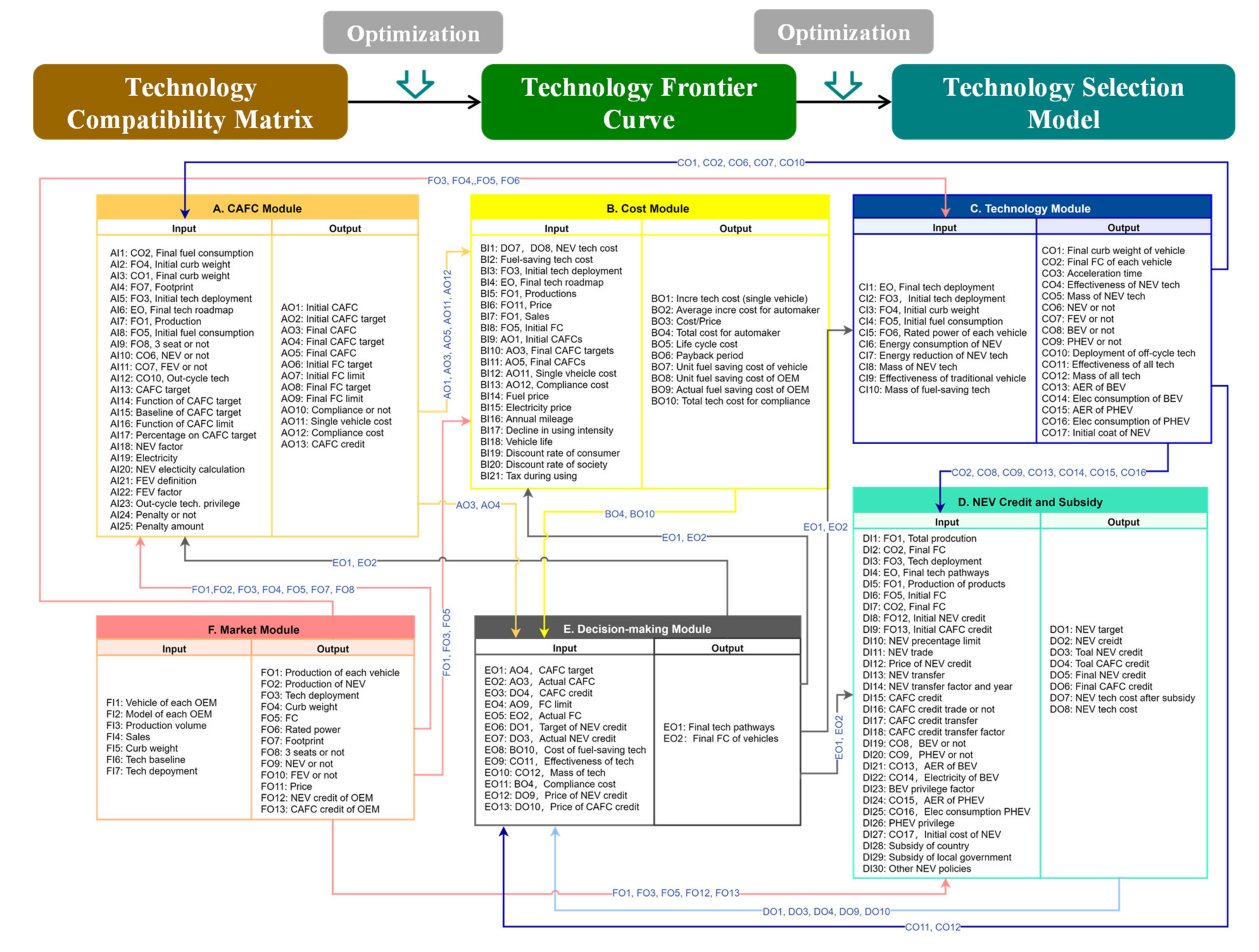



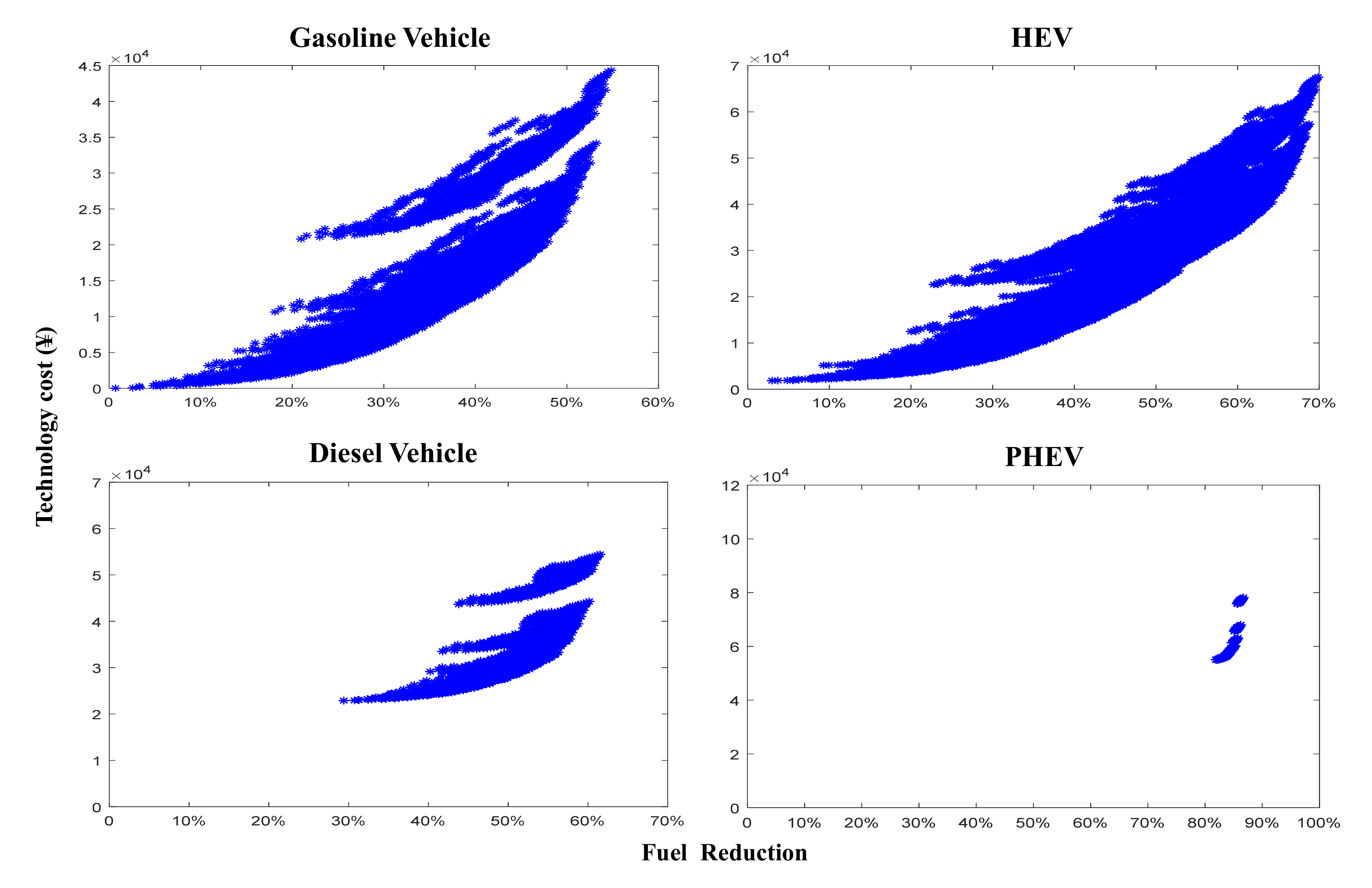
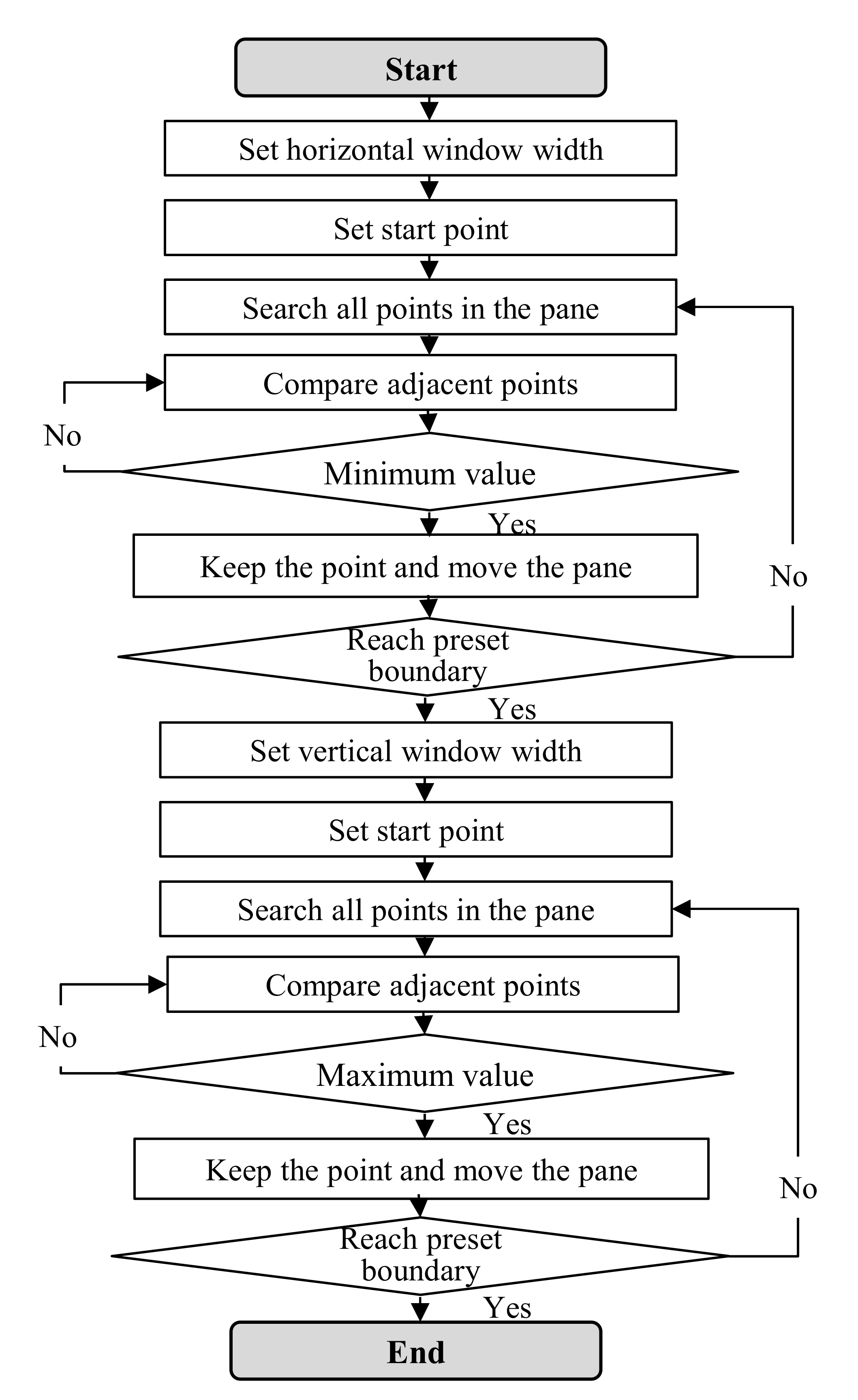



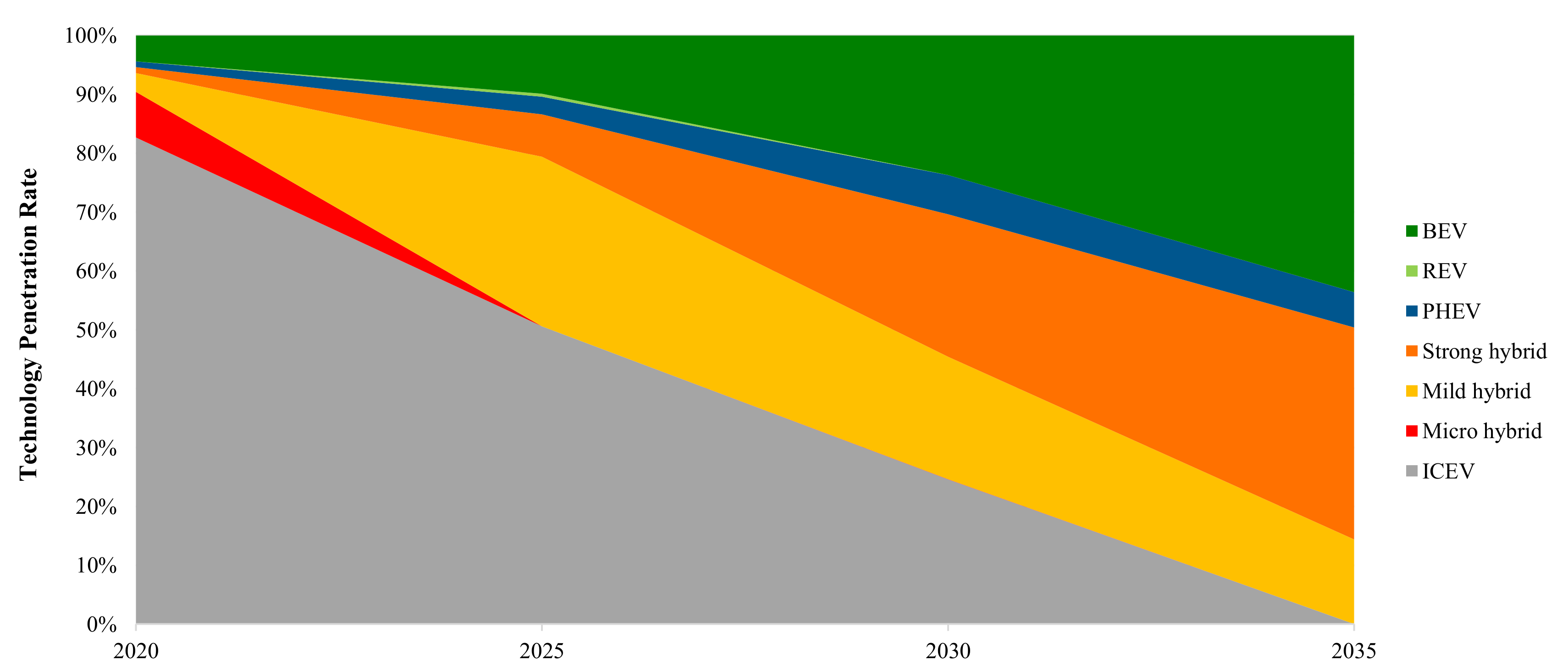

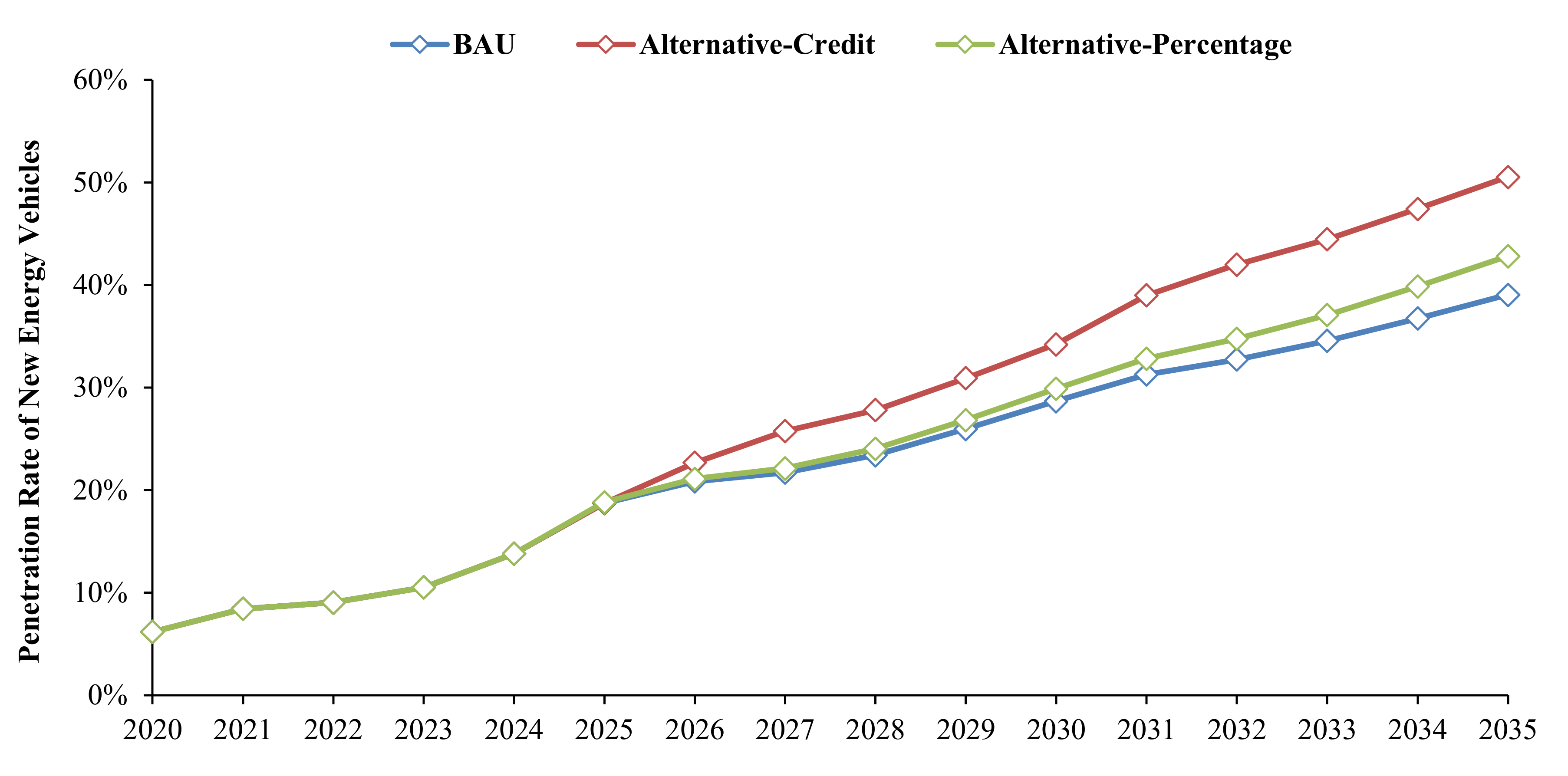


| Segment | Gasoline Vehicles | Diesel Vehicles | ||||
|---|---|---|---|---|---|---|
| Parameter | Curb Weight (kg) | Wheelbase (m) | Footprint (m2) | Curb Weight (kg) | Wheelbase (m) | Footprint (m2) |
| Small | 1090 | 2.5 | 3.6 | 1240 | 2.5 | 3.7 |
| Compact | 1380 | 2.7 | 4.1 | 1510 | 2.7 | 4.1 |
| Midsize | 1520 | 2.8 | 4.3 | 1660 | 2.8 | 4.3 |
| Large | 1850 | 3.0 | 4.6 | 1930 | 3.0 | 4.7 |
| Parameters | Description |
|---|---|
| Collection of fuel-efficient technologies available to OEMs | |
| Collection of OEMs’ vehicle models | |
| Corresponding year | |
| Function of fuel consumption limit | |
| Function of fuel consumption target | |
| Cost of energy-saving technology | |
| Energy-saving effectiveness of technology, | |
| Fuel consumption after technology application | |
| Fuel consumption limit after technology application | |
| Mass of vehicles after technology application | |
| Production volume of vehicles | |
| Fuel consumption target after technology application | |
| Privilege factor of NEVs | |
| Technology decision vector of model j | |
| Number of CAFC credit | |
| Unit price of NEV credit | |
| Number of credit lacked | |
| ,,,,,, | Initial parameters and technology application |
Publisher’s Note: MDPI stays neutral with regard to jurisdictional claims in published maps and institutional affiliations. |
© 2021 by the authors. Licensee MDPI, Basel, Switzerland. This article is an open access article distributed under the terms and conditions of the Creative Commons Attribution (CC BY) license (https://creativecommons.org/licenses/by/4.0/).
Share and Cite
Chen, K.; Zhao, F.; Hao, H.; Liu, Z.; Liu, X. Hierarchical Optimization Decision-Making Method to Comply with China’s Fuel Consumption and New Energy Vehicle Credit Regulations. Sustainability 2021, 13, 7842. https://doi.org/10.3390/su13147842
Chen K, Zhao F, Hao H, Liu Z, Liu X. Hierarchical Optimization Decision-Making Method to Comply with China’s Fuel Consumption and New Energy Vehicle Credit Regulations. Sustainability. 2021; 13(14):7842. https://doi.org/10.3390/su13147842
Chicago/Turabian StyleChen, Kangda, Fuquan Zhao, Han Hao, Zongwei Liu, and Xinglong Liu. 2021. "Hierarchical Optimization Decision-Making Method to Comply with China’s Fuel Consumption and New Energy Vehicle Credit Regulations" Sustainability 13, no. 14: 7842. https://doi.org/10.3390/su13147842
APA StyleChen, K., Zhao, F., Hao, H., Liu, Z., & Liu, X. (2021). Hierarchical Optimization Decision-Making Method to Comply with China’s Fuel Consumption and New Energy Vehicle Credit Regulations. Sustainability, 13(14), 7842. https://doi.org/10.3390/su13147842







